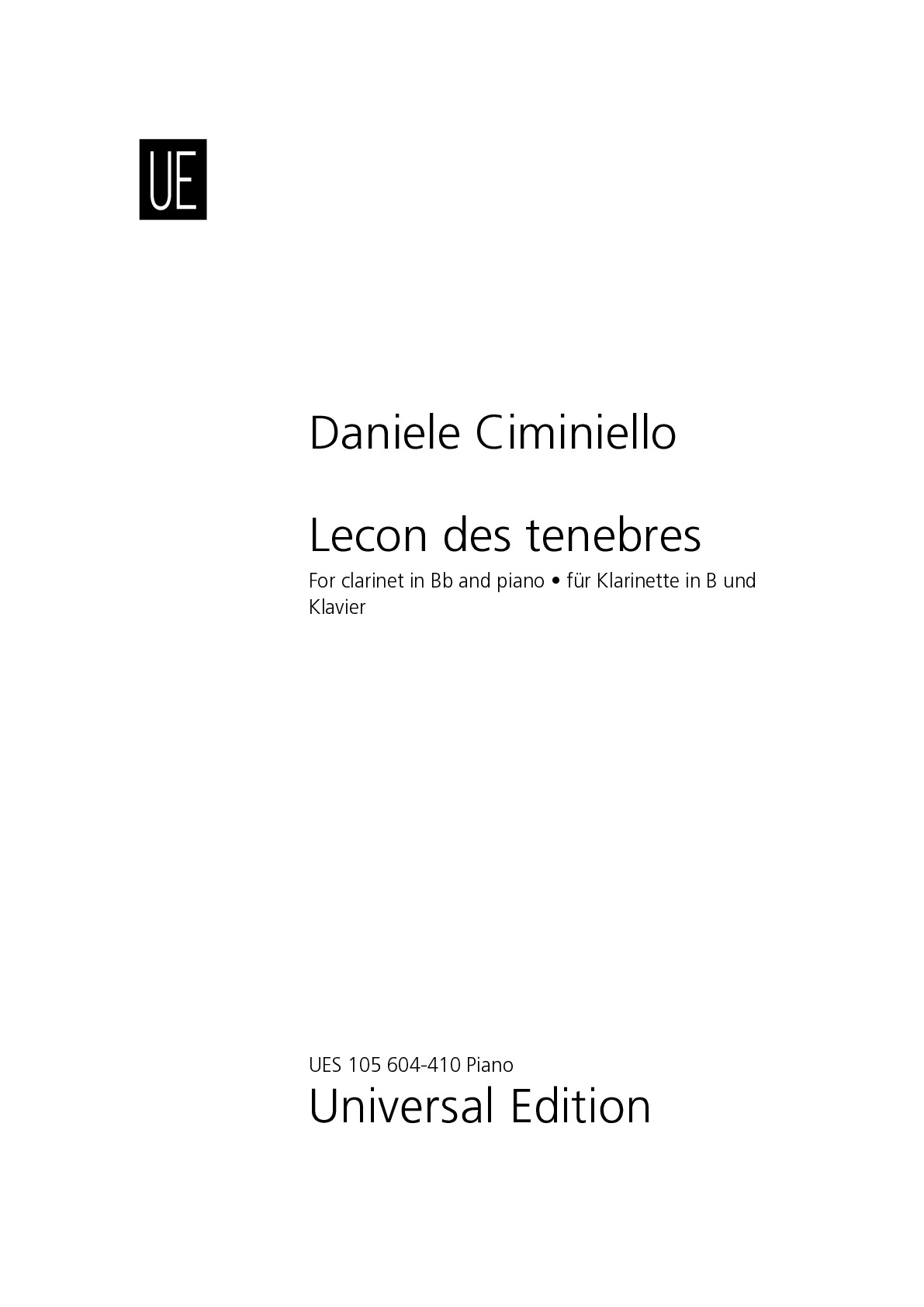.png)
Digital edition
immediately available as PDF
€14.95
Payments:
Shipping:
Daniele Ciminiello
Klavier (Leçon des ténèbres)
UES105604-410
Type: Stimme
Format: 210 x 297 mm
Pages: 28
Digital edition
immediately available as PDF
€14.95
Payments:
Shipping:
Audio preview
Description
“Leçon des ténèbres” (“Lecture of the darkness”) is a work in four movements for clarinet in Bb and piano that I composed in 2018. Each movement is inspired by a few verses taken from a poem that talks about darkness. The idea of the title comes from the homonymous compositions of the French Baroque repertoire, although their content and the purpose are totally different.
The first movement, “Nùx” (Night) is inspired by one of the most famous fragments by Saffo, one of the most representative poets of ancient Greece. In these verses she describes a night landscape lightened only by the light produced by the moon and the stars, which colors the ground silver . The interval of compound fifth in the opening creates from the start a nocturnal and ancient atmosphere. During the whole movement the piano performs an ostinato, while the clarinet creates delicate textures thanks to multiphonics made with two notes. This situation is interrupted by a short percussive element performed by the clarinet with the slap technique and the piano with stopped strings, both in the low register. At bar 36 the piano starts playing a short melody, then repeated at bar 50, but it always dies away in the nocturnal soundscape.
The second movement, “Icheb chirac 1”, is primarily inspired by a poem by William Blake, but it's also the first reference to Goethe's “Western-Eastern Diwan”. In several poems included in this collection the great German poet describes a nocturnal atmosphere lightened by the carbuncle, a stone which was believed to produce light in the darkness. The French writer Jean Chardin reports than in the ancient Persia this stone was called “Icheb Chirac”, literaly night torch. Therefore, the two pieces in this suite that are named after this stone are inspired by verses of poems which describe something shining in the darkness. Blake's poem describes a symbolic “Tyger” (the “y” on behalf of the “i” marks the symbolism of this character) shining like fire in the night. This movement has a more melodic structure than the previous one. The two instruments share the same melody, arranged into a micro-polyphonic texture. At bar 76 they separate, with the clarinet that moves down reaching its low range, and the piano that moves up reaching its high range. Then the piano descends into its low range, closing the movement with a cluster merged with a clarinet's loud multiphonic.
The third movement, “Les ténèbres”, is inspired by a poem by Charles Baudelaire which describes a painter condemned by God to paint on the darkness. The piano creates this “canvas of darkness” with a very slow ostinato in the extreme low range, played very softly and using both the soft and the sustain pedal throughout the all piece. On this canvas the clarinet “paints” a melody in its low range, including also some glissandos. This situation is interrupted at bar 110 and 125 by an a short reprise of the first movement, with the clarinet performing delicate multiphonics and the piano echoing the ostinato on the lowest A with the stopped string.
The fourth movement, “Icheb Chirac 2”, is divided into two parts. In the first part the echo of the first movement continues. On the ostinato the piano performs chords that act as transients for the clarinet's bisbigliandos, which create a melody. This melody is interrupted several times by a small cell built with fast notes played by both clarinet and piano. At bar 178 the second part starts and that cell develops creating a loop in piano's low range. On this loop the previous element built with the piano's chords and the clarinet's bisbigliandos evolves in something more rhythmic, and the bisbigliandos are substituted by flatterzunge technique, interspersed with slaps. At bar 189 the piano's loop becomes a new element shared by both instruments, which moves ascending and descending immediately after, going back to the previous situation. Starting from bar 204 slaps are substituted by glissandos and the piano's loop stops, becoming a more complex rhythm which moves gradually to the high range of the instrument and immediately after descends to the very low range. Here, from bar 215, the piano performs a new loop characterized by a high degree of dissonance. At bar 217 the clarinet performs a glissando in the range of three octaves, which ends on its high range, matched by a cluster in the piano's low range.
More information
Type: Stimme
Format: 210 x 297 mm
Pages: 28

